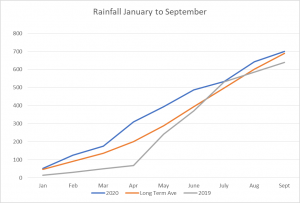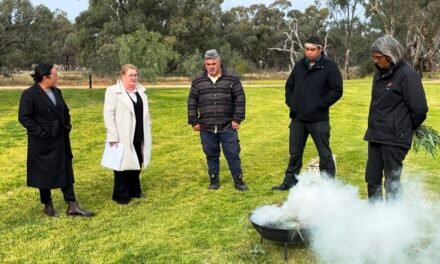Victor Szwed
September’s rainfall for Daylesford has been below average at 57.4mm compared to the long term mean of 88.5mm. Official rainfall readings relate to the 24 hours to 9am on a particular day. Consequently, the steady rainfall throughout Wednesday September 30th is read at 9am on October 1st and counts toward the October total. Yes, we had some good rain at the very end of September but we can’t expect our friendly local weather people to get up in the middle of the night to empty their rain gauges…
We are still slightly above the yearly average cumulative rainfall with just on 700mm to date compared to the long-term 689.6mm at the end of September.
To put these numbers in perspective, it’s helpful to look at rainfall records for Daylesford. 1982 was the driest year since records began in 1868 with 420.8mm of rain, less than half the long term mean of 876.9mm. 1973 was the wettest year on record with 1,321.5mm. May 1960 was the wettest month on record with 252.5mm almost 30% of a typical year’s rain in one month!

Cumulative 2020 rainfall to the end of September. 2020 rainfall (blue) is slightly above the long term average (orange). 2019 rainfall at this point in the year (grey) was slightly below the long term average.
More than average rain is expected for the remainder of the year. The Weather Bureau’s advises that La Niña is underway in the Southern Pacific. This pattern based on ocean surface temperatures typically means higher than average rainfall particularly in eastern Australia. All eight surveyed international models used by the Bureau indicate that La Niña thresholds have been met. Five of the models indicate that La Nina values will be maintained into early 2021. The Bureau predicts that most of Australia should see wetter than normal conditions over the coming 3 to 4 months. Great for the garden!
Temperatures are expected to be a little above average over coming months. While we have had a couple of snow days, there have not been many frosts in recent weeks.
Daylesford’s water supplies are 100 per cent full according to Central Highlands Water. Each of our reservoirs, Wombat, Bullarto and Hepburn, are full.
Want to know more about our weather? Just go to the Bureau’s web site and explore lots of information about weather, climate change, water, marine, environment and more.





